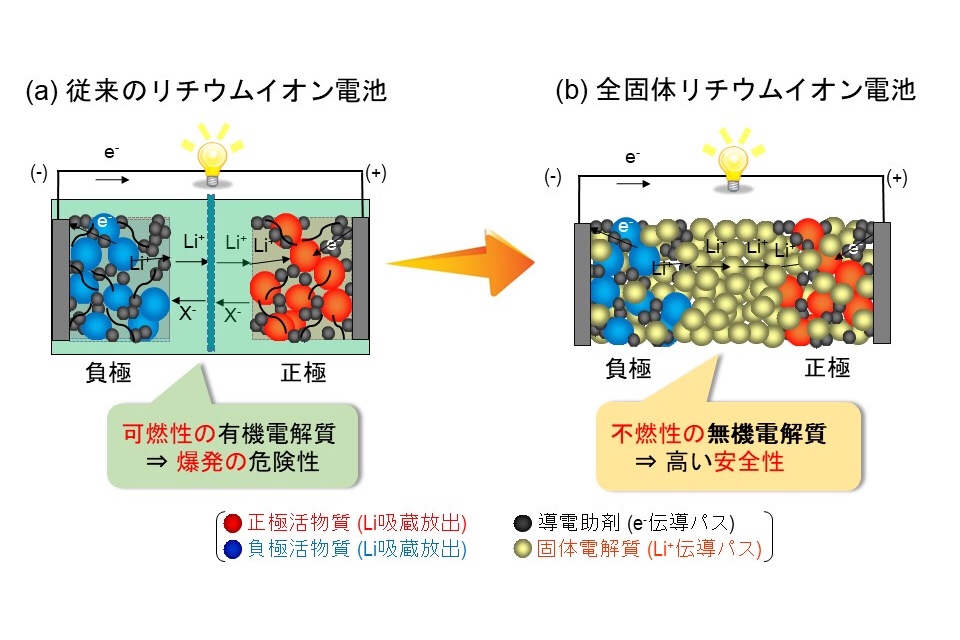
図1. 従来のリチウムイオン電池 (a) と全固体リチウムイオン電池 (b) の模式図。

図2. 高イオン伝導性と高成形性を併せ持つ固体電解質材料探索のための網羅計算結果。
名古屋工大:全固体LiB新材料を開発:内部密度94%(動画):
NITech: New all-solid-state LiB material: Internal density 94%:
名古屋工业大学:新型全固态LiB材料的开发:内部密度94%
- 金属Li短絡抑制に効果:新規塩化物固体電解質、安全な車載電池実現へ -
名古屋工大:
高成形性の塩化物固体電解質材料を開発しました。
高エネルギー密度を有するリチウム金属電極(*2)で、安定した充放電サイクルを実現しました。
塩化物固体電解質材料:
固体電解質材料に求められる物性指標を設定。
構造データベース中の材料に対し、網羅的に計算、効率的材料を探索しました。
その中で、
- 有毒ガスや高温処理が必要な塩化物材料に対し、「不活性ガス常温・常圧下での合成」に成功しました。
- また、圧粉のみ低環境負荷のプロセスで、「リチウム金属負極の課題である短絡現象を抑制すること」ができました。
固体電解質が重要な鍵:
全固体電池の高エネルギー密度化には、「固体中をリチウムイオンが伝導する固体電解質」が重要な鍵を握ります。
この新材料は、全固体電池の高エネルギー密度化を実現するものです。
名古屋工業大学
https://www.nitech.ac.jp/news/press/2020/8406.html
Metastable Chloride Solid Electrolyte with High Formability for Rechargeable All-Solid-State Lithium Metal Batteries
Naoto Tanibata*, Shuta Takimoto, Koki Nakano, Hayami Takeda, Masanobu Nakayama, and Hirofumi SumiACS Materials Letters
Abstract
Dense solid electrolytes in all-solid-state Li batteries
are expected to suppress Li dendrite phenomena that prevent the application of high-energy-density Li metal electrodes.
However, voids and cracks in sintered electrolytes still permit short-circuiting due to Li dendrites.
This study aimed to investigate solid electrolytes with high formability in which green compacts can prevent Li dendrites.
Li+ ion migration energies, bulk moduli, and energies above the hull
were comprehensively investigated using first-principles and classical force field calculations as the indicators for ionic conductivity, formability, and thermodynamic stability.
The 231 compounds containing Li and Cl listed in the Materials Project database were studied due to their high polarizability and weak Coulombic interaction with Li+ ions.
Among them, monoclinic LiAlCl4 (LAC, S.G.: P121/c1) was focused on, owing to its low values of all three indicators.
A mechanochemical synthesis
was attempted to prepare the metastable phase, where Li ions occupy the interstitial sites, not just the original sites, because the computation for the migration energy suggested conductive pathways between the original Li sites.
XRD and 7Li-MAS NMR measurements indicated that
the mechanochemically synthesized LAC possessed a monoclinic host structure, while 2.5% Li occupied interstitial tetrahedral sites.
Impedance measurements
showed that the LAC green compacts exhibited an ionic conductivity of 2.1 × 10–5 S cm–1, 20 times higher than the conventional solid-state synthesized LAC at room temperature.
The conductivity
was more than one order of magnitude higher than that of garnet-type Li6.6La3Zr1.6Ta0.4O12 (LLZT), which has been attractive for the application of the sintered body for Li metal electrodes.